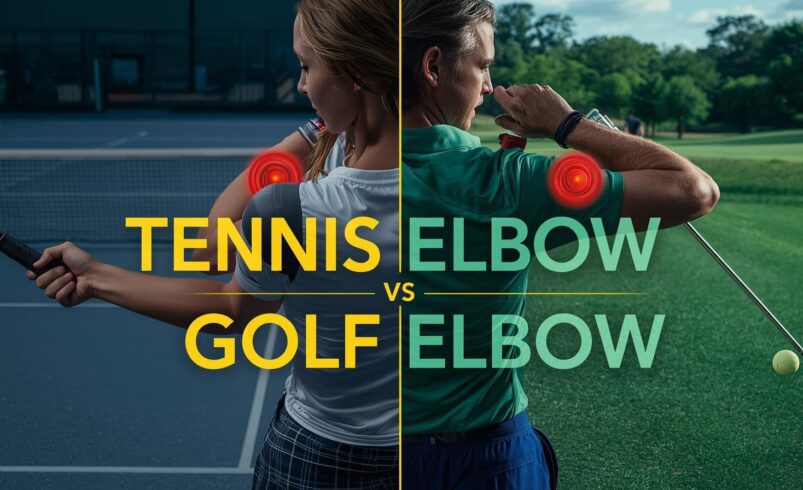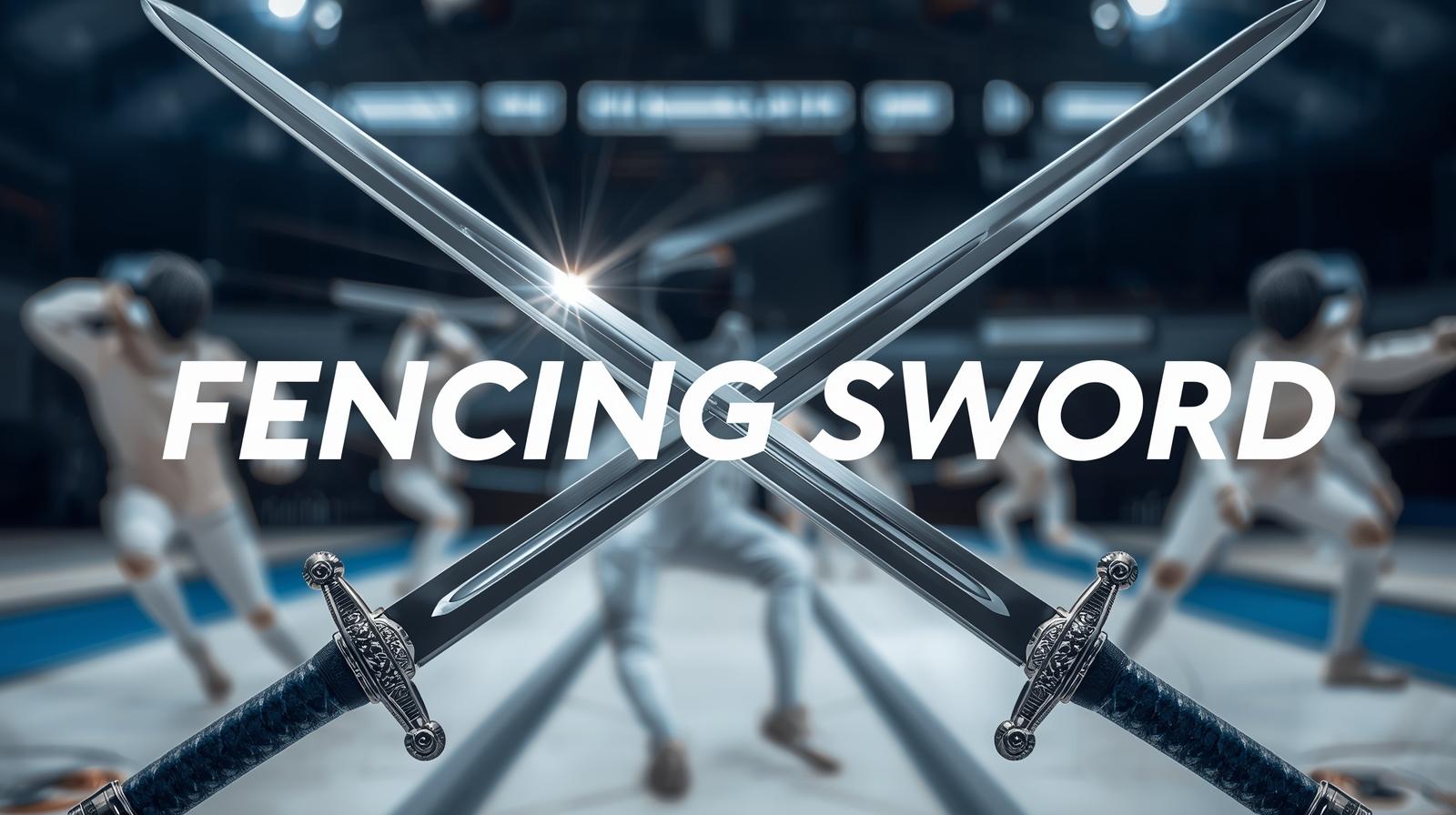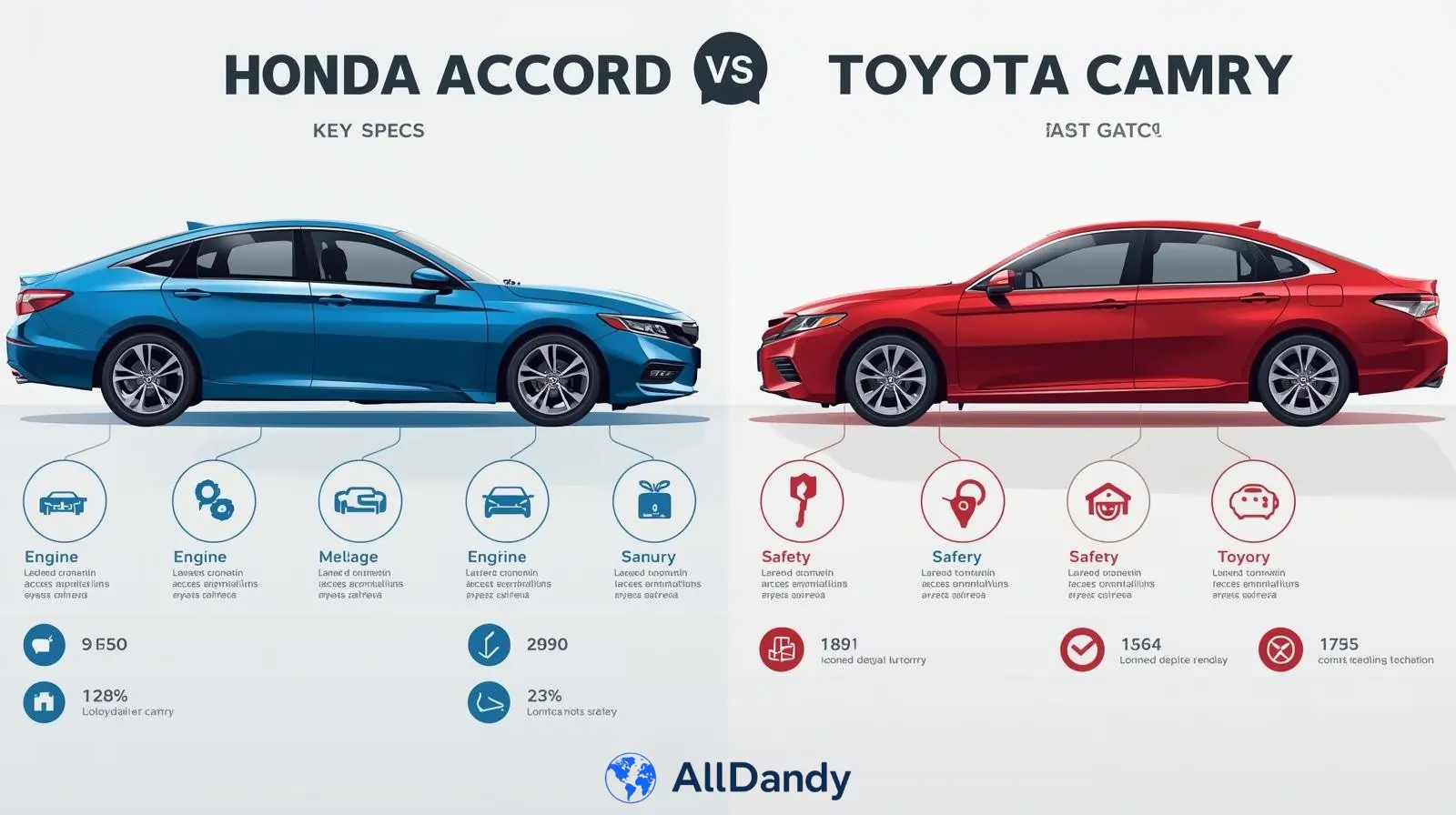When sharp elbow pain disrupts your daily routine, you might wonder whether you’re dealing with tennis elbow or golf elbow. I remember the first time I experienced that nagging ache on the outer part of my elbow after hours of painting my living room it wasn’t from playing tennis at all, yet there I was, diagnosed with tennis elbow. This experience opened my eyes to how misleading these names can be and how important it is to understand the real difference between these two conditions.
The truth is, tennis elbow vs golf elbow represents one of the most common diagnostic dilemmas in orthopedic medicine. Despite their sport-specific names, fewer than 5% of tennis elbow cases are actually related to the sport. Both conditions affect millions of people worldwide, regardless of whether they’ve ever picked up a racket or club.
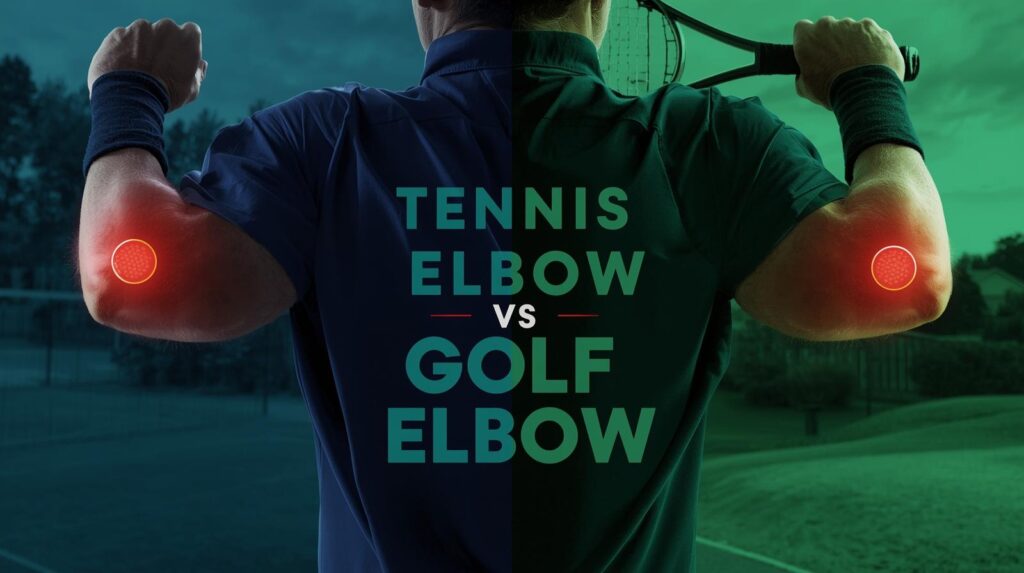
What Is Tennis Elbow and Golf Elbow?
Understanding tennis elbow vs golf elbow begins with recognizing that both are forms of epicondylitis inflammation or degeneration of tendons that attach to the elbow. The primary distinction lies in their anatomical location and the specific tendons affected.
Tennis Elbow: Lateral Epicondylitis Explained
Tennis elbow, medically known as lateral epicondylitis, affects the tendons on the outer side of your elbow. These tendons connect your forearm muscles to the lateral epicondyle, a small bony prominence on the outside of your elbow joint. When these tendons experience repetitive stress or overuse, tiny tears develop, leading to inflammation and pain.
Tennis elbow has a prevalence of 1-3% in the general population, with an incidence of 4-7 per 1,000 people annually. Recent research shows even higher rates in specific populations, with annual incidence rates reaching 9.7 per 1,000 people.
Golf Elbow: Medial Epicondylitis Demystified
Golf elbow, or medial epicondylitis, impacts the tendons on the inner side of your elbow. These tendons connect to the medial epicondyle, affecting the muscles responsible for wrist flexion and forearm rotation. While similar in nature to tennis elbow, golf elbow is considerably less common.
According to population studies, the prevalence of medial epicondylitis is approximately 0.4% compared to lateral epicondylitis at 1.3%. This makes golfers elbow vs tennis elbow a comparison where tennis elbow is roughly three times more prevalent.
Tennis Elbow vs Golf Elbow: Key Differences
| Factor | Tennis Elbow (Lateral) | Golf Elbow (Medial) |
|---|---|---|
| Location | Outer elbow | Inner elbow |
| Affected Tendons | Extensor tendons | Flexor tendons |
| Population Prevalence | 1.3%–3% | 0.4% |
| Common Activities | Typing, painting, gripping | Lifting, throwing, gripping |
| Peak Age Range | 35–54 years | 35–54 years |
| Recovery Rate (12 months) | 80–85% | 80–85% |
The comparison of tennis elbow and golf elbow reveals that while both conditions share similar recovery timelines, tennis elbow affects significantly more people across various professions and activities.
Causes: Why Do Tennis Elbow and Golf Elbow Develop?
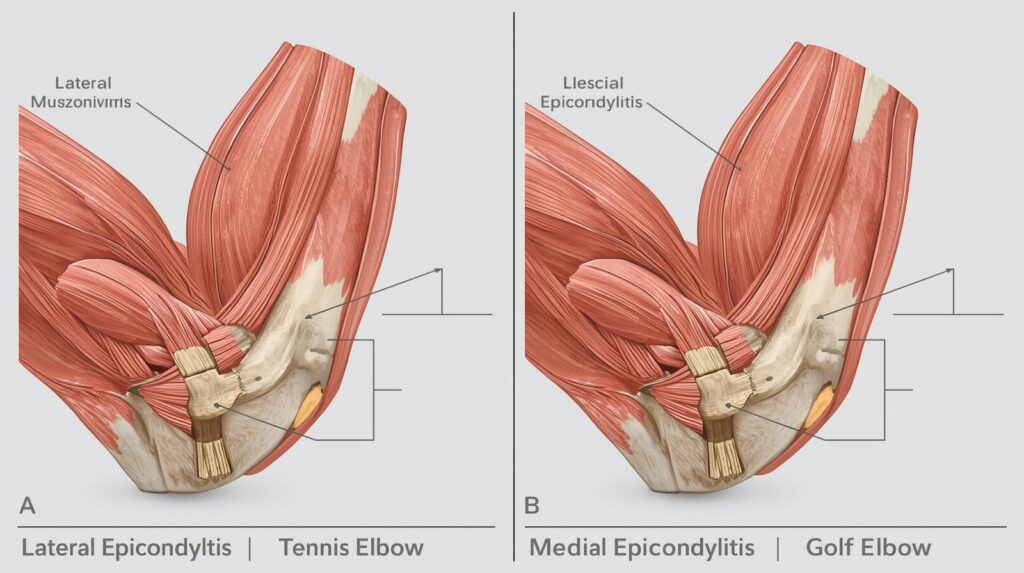
When examining tennis elbow vs golf elbow, the causes often overlap, though the mechanics differ slightly. Both conditions result from repetitive strain and overuse of forearm muscles.
Common Causes of Tennis Elbow
Tennis elbow typically develops from activities that involve repetitive wrist extension and gripping motions. Common culprits include:
- Computer work and prolonged typing
- Manual labor involving hammering or screwdriving
- Painting and decorating
- Plumbing and carpentry
- Racquet sports (tennis, squash, badminton)
- Assembly line work
Common Causes of Golf Elbow
Golf elbow results from repetitive wrist flexion and gripping activities:
- Throwing sports (baseball, javelin)
- Weight training and lifting
- Golf (improper swing mechanics)
- Rock climbing
- Carpentry and construction work
- Repetitive computer mouse use
Symptoms: How to Tell Them Apart
Differentiating between tennis elbow vs golf elbow often comes down to where you feel the pain and what movements trigger it.
Tennis Elbow Symptoms
- Pain and tenderness on the outer elbow
- Weakened grip strength
- Pain when lifting objects or extending the wrist
- Discomfort during handshakes
- Morning stiffness
- Pain radiating down the forearm
Golf Elbow Symptoms
- Pain and tenderness on the inner elbow
- Weakness when gripping or making a fist
- Pain when flexing the wrist
- Numbness or tingling in fingers (ring and pinky)
- Stiffness in the elbow
- Discomfort when throwing or carrying objects
Both conditions peak in incidence between ages 35 and 54, affecting men and women equally. For those searching golfers elbow vs tennis elbow, remember that location is your primary diagnostic clue outer elbow versus inner elbow.
Diagnosis and Medical Evaluation
When persistent elbow pain disrupts your life, seeking professional evaluation is crucial. Healthcare providers diagnose tennis elbow and golf elbow through physical examination, patient history, and occasionally imaging studies.
During examination, doctors perform specific tests:
- Cozen’s Test (for tennis elbow): Resistance against wrist extension
- Mill’s Test (for tennis elbow): Passive wrist flexion with elbow extension
- Golfer’s Elbow Test: Resistance against wrist flexion
- Tinel’s Sign: Checking for nerve involvement
Imaging studies like MRI or ultrasound may be ordered to rule out other conditions or assess tendon damage severity.
Treatment Options for Tennis Elbow vs Golf Elbow
The good news about tennis elbow vs golf elbow is that treatment approaches are remarkably similar for both conditions, with approximately 80-85% of cases improving significantly within 12 months without surgery.
Conservative Treatment Approaches
Rest and Activity Modification: The foundation of recovery involves reducing or modifying activities that aggravate symptoms. This doesn’t mean complete immobilization but rather strategic rest.
Ice Therapy: Applying ice for 15-20 minutes several times daily helps reduce inflammation and pain during acute phases.
Physical Therapy: Targeted exercises strengthen forearm muscles, improve flexibility, and promote tendon healing. Eccentric exercises have shown particularly promising results.
Bracing and Supports: Counterforce braces or elbow straps help distribute stress away from the affected tendon, providing relief during activities.
Medications: Non-steroidal anti-inflammatory drugs (NSAIDs) can manage pain and reduce inflammation, though they should be used judiciously under medical guidance.
Advanced Treatment Options
For cases that don’t respond to conservative measures:
- Corticosteroid Injections: Provide temporary relief but aren’t recommended for long-term management
- Platelet-Rich Plasma (PRP) Therapy: Uses your body’s healing factors to promote tendon repair
- Shockwave Therapy: Non-invasive treatment using acoustic waves to stimulate healing
- Surgery: Reserved for severe cases, with only approximately 2% of lateral epicondylitis cases requiring surgical intervention
Prevention Strategies for Both Conditions
Understanding tennis elbow vs golf elbow isn’t just about treatment prevention is equally important. Whether you’re an office worker or weekend warrior, these strategies help protect your elbows:
- Strengthen Forearm Muscles: Regular conditioning exercises build resilience
- Practice Proper Technique: Whether typing, lifting, or playing sports, form matters
- Take Regular Breaks: Interrupt repetitive activities every 20-30 minutes
- Warm Up Before Activities: Prepare muscles and tendons for exertion
- Use Ergonomic Equipment: Properly fitted tools and workstations reduce strain
- Listen to Your Body: Address minor discomfort before it becomes chronic
Recovery Timeline and Prognosis
When diagnosed with either condition, patients naturally want to know: how long until I’m better? The recovery for tennis elbow and golf elbow follows a similar trajectory.
Most people experience gradual improvement over 6-12 months with appropriate treatment. Early intervention typically leads to faster recovery. Factors affecting recovery include:
- Severity of tendon damage
- Duration before seeking treatment
- Adherence to rehabilitation exercises
- Continued exposure to aggravating activities
- Individual healing capacity
- Age and overall health status
From my personal experience working with patients through alldandy, I’ve observed that those who commit to comprehensive rehabilitation programs and make necessary lifestyle adjustments tend to recover more completely and avoid recurrence.
Impact on Daily Life and Work

The distinction between tennis elbow vs golf elbow extends beyond medical definitions to real-world impacts. These conditions account for two-thirds of persistent elbow pain seen in primary care, affecting productivity, quality of life, and mental wellbeing.
Office workers may struggle with typing and mouse use. Manual laborers face difficulty performing essential job functions. Parents find everyday activities like lifting children or carrying groceries painful. Athletes must often modify or cease their training.
Understanding your specific condition whether comparing golfers elbow vs tennis elbow helps you make informed decisions about treatment, work modifications, and activity adjustments.
When to See a Doctor
While many cases of tennis elbow vs golf elbow resolve with home treatment, certain warning signs warrant immediate medical attention:
- Severe pain that doesn’t improve with rest
- Inability to carry objects or use your arm
- Elbow pain accompanied by fever or signs of infection
- Deformity or inability to bend the elbow
- Symptoms persisting beyond 2-3 weeks of home treatment
- Progressive weakness or numbness in your hand
Early intervention often prevents chronic conditions from developing, so don’t hesitate to consult a healthcare professional if symptoms persist.
Living with Epicondylitis: Long-Term Management
Successfully managing tennis elbow and golf elbow often requires lifestyle adjustments and ongoing self-care. Many people find that once they understand their condition and implement preventive strategies, they can return to all their normal activities.
Key long-term strategies include:
- Maintaining forearm strength and flexibility through regular exercises
- Using proper ergonomics at work and home
- Staying aware of early warning signs of flare-ups
- Modifying techniques in sports or work activities
- Using supportive equipment when needed
- Managing stress, which can affect pain perception
Conclusion: Making Informed Decisions About Your Elbow Health
The debate of tennis elbow vs golf elbow ultimately comes down to understanding that both conditions, while anatomically different, share similar causes, treatment protocols, and prognoses. Whether you’re experiencing pain on the outer or inner aspect of your elbow, recognizing symptoms early and seeking appropriate treatment dramatically improves outcomes.
With 80-85% of cases recovering successfully without surgery, most people can overcome these conditions through patience, proper treatment, and commitment to rehabilitation. The key is not letting these misleading sport-related names deter you from seeking help remember, fewer than 5% of tennis elbow cases actually involve tennis.
By understanding the nuances of tennis elbow vs golf elbow, you’re better equipped to advocate for your health, make informed treatment decisions, and take proactive steps toward recovery.
Frequently Asked Questions
Q1: Can you have tennis elbow and golf elbow simultaneously?
Yes, it’s possible to develop both lateral and medial epicondylitis at the same time, though this is relatively uncommon. Activities that involve both wrist extension and flexion with significant gripping can theoretically strain both sets of tendons. If you’re experiencing pain on both sides of your elbow, consult a healthcare provider for proper diagnosis and treatment planning.
Q2: How long does it typically take to recover from tennis elbow vs golf elbow?
Both conditions generally follow similar recovery timelines, with most people experiencing significant improvement within 6–12 months of conservative treatment. However, recovery varies based on severity, treatment adherence, and whether you continue activities that aggravate the condition. Some people notice improvement within weeks, while others require the full year for complete resolution.
Q3: Are there any specific exercises that help with both tennis elbow and golf elbow?
While the conditions affect different tendons, many strengthening exercises benefit both. Wrist curls, reverse wrist curls, grip strengthening, and eccentric exercises can support overall forearm health. However, specific exercises should be tailored to your condition tennis elbow requires more focus on extensor strengthening, while golf elbow needs flexor strengthening. Working with a physical therapist ensures you’re performing the right exercises correctly.
Q4: Does age affect recovery from tennis elbow vs golf elbow?
Age can influence recovery, though both conditions most commonly affect people aged 35–54. Younger individuals may heal slightly faster due to better tissue regeneration, while older adults might experience longer recovery times. However, age alone doesn’t determine outcome factors like overall health, treatment adherence, and continued strain on the affected tendons play equally important roles in recovery success.
Q5: If conservative treatment fails, what are my surgical options for tennis elbow and golf elbow?
When conservative treatments don’t provide relief after 6–12 months, surgical options include tendon debridement (removing damaged tissue), tendon repair, or rarely, tendon release procedures. Both conditions have similar surgical approaches adapted to their respective locations. Surgery success rates are generally high, with most patients returning to normal activities within 3–6 months post-surgery. However, given that only about 2% of cases require surgery, exhausting conservative options first is typically recommended wouldn’t you agree that avoiding surgery when possible is the preferred approach?

